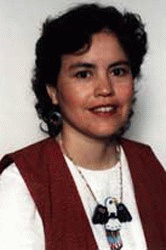|
As a Native of Southeast Alaska (I am Haida and Tlingit), I see how involved our people are with their local surroundings. Native peoples depend on the low tides to harvest beaches packed with shellfish and seaweeds. We are aware of the ebb and flow of the waters and how that can impact safe water travel. We are aware of the relationship between the moon and the tide. Historically the changing of the seasons and years were measured by the phases of the moon. Many of these moon phases' names (e.g. moon of the salmon) indicated which foods were abundant during that time.
 |
| Dr. Dolly Garza |
 |
This knowledge was often passed down the generations through oral storytelling. Stories were told of how Raven brought us the sun, the moon, and the stars, and how the tide woman agreed to provide low tides so we may eat the foods found when the tide is out. Over time many of these oral stories have been transcribed as legends and myths.
However, these stories were and are more than just myths to the Tlingit peoples. The Elders must have known that the young ones would hold onto exciting stories but might not keep their attention focused when listening to long monologues. Stories were told to children to teach lessons of respect, place, and history.
These stories and histories can still teach our young, and perhaps they will hold our children's interest long enough so that they learn these valuable lessons. This is part of the goal of "Tlingit Moon and Tide," to integrate these traditional lessons back into the curriculum at the public schools.
"Tlingit Moon and Tide" is the result of teachers in Southeast Alaska who felt the need to represent Southeast Native culture in schools, specifically in the science curriculum. The National Science Foundation's Rural Systemic Initiative, whose goal is to increase the number of Native students in sciences by making science curriculum and activities relevant to local communities and cultures, funded the project.
Several Southeast teachers took this goal and drafted "Tlingit Moon and Tide," developing the educational units to target students in the lower grades. Their hope was to hook young students while they are still interested in the mysteries of the world.
Most elementary curriculum includes lessons on the moon and the tides. Expanding the scope of the studies to encompass the "Tlingit Moon and Tide" was easy since Tlingit people are intimately tied to their area's ecosystem. "Tlingit Moon and Tide" includes a resource guide that offers ideas and examples of how to use Native legends and local culture and surroundings to teach science in the school.
|




